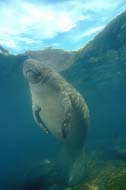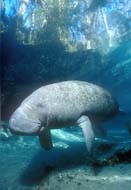|
I spent three days in February snorkeling with manatees at Crystal River, FL. The town is easy to reach—only about 1.5 hours by car north of the Tampa airport—the only annoyance being the five $1.00 tolls you have to pay EACH WAY on Highway 589. Even the Golden Gate Bridge District (hardly considered a paragon of financial astuteness, since they still lose money even with a $6.00 auto toll) figured out about 50 years ago they you can cut costs and traffic backups by doubling the toll and charging ONE WAY.
Florida manatees (Trichechus manatus latirostrus) are a subspecies of the West Indian manatee. They are an endangered species, with a population estimated at about 3,300 animals in the state. While adult manatees average ten feet in length and about 1,200 pounds, their metabolism is very low, so they don’t generate a lot of body heat. In the colder winter months, they move from the Atlantic Ocean on the east coast or the Gulf of Mexico on the west coast into rivers and the natural springs that feed them, where the water temperature is a constant (and warmer) 72 degrees. More than 25 percent of the FL manatee population congregates in winter at the Crystal River National Wildlife Refuge. This is also one of the few areas where it’s legal to swim with them.
|

|

|
The two photos above were taken on prior manatee trips—it’s been about a decade since my last visit. I’d hoped for similar sunny conditions on this trip, because the ambient light really contributes to an attractive photograph. No such luck, however—it was overcast all three days I was in the water with them. Thus I didn’t get anything this time that was as good as these two shots.
Since there wasn’t sun, I tried for shots that included some of the animals’ reflections on the surface. In the lower-left shot above, you can see some of the “toenails” that manatees have on each flipper—they resemble what you see on the foot of an elephant, and that’s no coincidence. Manatees also have tough, grayish-brown wrinkled skin that’s similar to an elephant’s. Using genetics, scientists have determined that manatees are more closely related to elephants than any other living animal. It is believed manatees lived on land long ago and ate grass like elephants, eventually evolving to the aquatic life. They are the only marine mammals that are herbivores (vegetarians), often eating over 150 pounds of plants, grass and weeds each day.
Seeing a cow and her calf together is always fun. “So homely it’s cute” is definitely a phrase that applies to young manatees! At birth, manatee calves weigh 60 to 70 pounds and are three to four feet long. Calves nurse for nearly a year and stay with their mother for up to two years, since reproduction is slow (one calf about every 3 years).
Manatees at Crystal River are acclimated to people and very friendly. It can be a tad disconcerting to be taking a photo of one, while another swims up behind you and starts nibbling on your shoulder, but they are quite harmless. A manatee will swim up to you expectantly, and if you rub under the flipper it will often roll over to have its tummy scratched, as shown in the lower-right photo above. Just like your dog at home—but these guys can top 13 feet and 3,000 pounds!
Snorkeling with manatees is a lot of fun and can be experienced by just about anyone. I was in a spring within King’s Bay called the Three Sisters, and there were people in the water who had never put on a mask & snorkel before! SCUBA diving is prohibited, since the air bubbles can disturb the manatees, and even free diving down using a snorkel is discouraged (although you are permitted to “sink” down—I was able to do this with just one four-pound weight while wearing a five mm wetsuit). Too bad about the lack of sun—guess I’ll just have to come back next winter!
Best to all,
Ken
http://www.seaimages.org
|